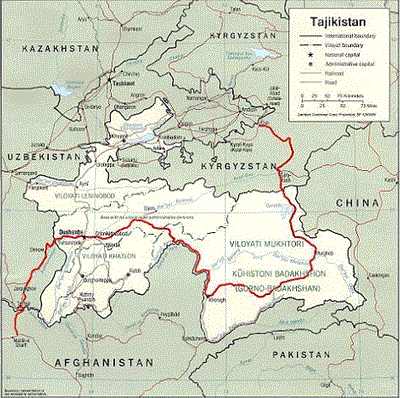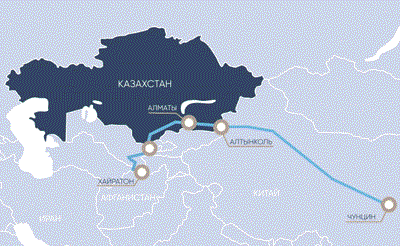>Top 2. Tajikistan Returns Land to China: (China Project Hub, 2025)
https://www.youtube.com/watch?v=pWOET8BgBLE
- Today's story takes us to one of the world's most remote and misunderstood regions: the Pamir Plateau - a place once considered lost to history, but now at the heart of a 21st century geopolitical transformation. Few expected that when this land was peacefully returned to China, it would reveal a treasure trove of strategic resources, instantly turning this high-altitude frontier into a hotbed*4 of global attention. Let's unravel*5 this fascination story - one that spans centuries of imperial conflict, cold diplomacy, and quiet triumph.
- The Pamir plateau, often referred to as the "Roof of the World," sits at the intersection of Central and South Asia, where modern-day China, Tajikistan, and Afghanistan converge. Towering above 4,000m, the region has long been isolated by its unforgiving terrain - permafrost, snow-laden ridgelines, and scarce infrastructure made it one of the least accessible areas on Earth. Yet historically, this land was never a void. It served as a vital artery*6 of the ancient Silk Road and a meeting point for civilizations from the East and West. During the Western Han*7 dynasty, the legendary envoy Zhāng Qiān (张骞 175-114BC) laid the foundation for Sino-Central Asian ties by traveling through this area. In the Tang dynasty, China further extended its administrative presence by establishing the Ānxī (安西) Protectorate to safeguard trade and influence across the region.
- Despite its strategic and symbolic significance, the Pamirs became collateral damage during the great power rivalries of the 19C. In 1864, weakened by internal decline and external pressure, the Qīng Empire signed the Treaty of Tarbagatai with Tsarist Russia, ceding over 440,000 sq.km of northwestern territory. while the Pamirs remained nominally Chinese, the Russians began asserting control. By 1882, Russian forces had occupied over 1,100 sq.km in the eastern Pamirs. China's response? A dotted line of a map and diplomatic silence - helpless in the face of growing imperialist aggression. For decades, the region disappeared from active Chinese governance. Under Soviet control, the area was militarized, yet underdeveloped. When Tajikistan became independent in 1991, it inherited these neglected borderlands, struggling with political instability, economic hardship, and limited capacity to govern such rugged terrain.
- But China never forgot. Archived in China's Ministry of Foreign Affairs were yellowed maps, imperial edicts*11, and Qing military logs - concrete records indicating historical jurisdiction*13 over the Pamirs. Even a satellite analysis was conducted to align historical claims with modern geography. China's approach wasn't to contest the border militarily, but slowly build a watertight*14 legal and diplomatic case, while extending a hand of cooperation. By 2011, after nearly two decades of low-profile*16 negotiations, China and Tajikistan signed a border agreement. Tajikistan formally acknowledged China's claim to 1,158 sq.km*17 of the eastern Parmirs. Crucially, this wasn't forced handover*18. China refrained from threats or coercion*19. Instead, the return was secured through diplomacy, documentation, and promises of shared development. And that's where the real surprise began.
- Soon after the agreement was signed, Chinese geological teams were dispatched to the plateau. In 2018, a group of frostbitten*20 surveyors carrying drilling rigs into the highlands expected little more than barren rock. What they found was anything but. At a depth of 300m, exploratory drills struck lithium. Not just trace amounts, but an extensive vein with industrial scale reserves. Lithium, the lifeblood of modern batteries, is the key component in electric vehicles, energy storage systems, and mobile devices. With global demand soaring due to the green transition. this discovery couldn't have been more perfectly timed*22.
- But lithium was just the beginning. The region was soon found to harbor rare earth elements - critical for producing advanced electronics, military radar systems, and fiber-optic cables. Among the rarest was promethium-based (Pm) alloys, used in aerospace and 5G infrastructure. Then came the gold: over 300,000 tons*24 in in preliminary estimates, valued at more than 1.2 trillion yuan*26 based on current prices. News of the discoveries reverberated*27 globally. The Wall Street Journal called it a "geoeconomic windfall*28." Western analysts remarked that China had acquired - through diplomacy - what many countries would have fought wars over. In Tajikistan, public opinion was mixed. Some citizens expressed regret, saying they would never have agreed to return the land if they had known about the resources beneath it.
- However, China had anticipated such sentiment. The agreement included a clause granting Tajikistan 3% of the annual mining profits. Additionally, China undertook major infrastructure projects, including a 2,100 km road connecting Dushanbe (Душанбе)*29 to the Pamir region. Travel time was reduced by three days, saving the Tajik economy billions annually in freight and logistics costs. But more than just roadways and royalties, China built hospitals, schools, and hydropower plants across eastern Tajikistan - quietly winning hearts and minds through action rather than slogans.
- The true power of this strategy lies in contrast. A century ago, China was forced to watch as foreign powers carved up its territory. Today, through archival*32 persistence, patient diplomacy, and a long-term development strategy, it has reclaimed what was once lost - without bloodshed, without headlines*33. The transformation is profound. Lithium from Pamir now feeds China's booming battery factories in Qīnghǎi (青海)*34. Rare earths support tech hubs in Sìchuān (四川). gold reserves underpin industrial expansion. And perhaps most symbolically, former Qing military outposts*36 - destroyed by Russian forces in 19C - have been rebuilt as patriotic education sites.
- In 2025, the region welcomed its first solar-power drone station and charging grid, signaling a shift toward sustainable high-altitude development. Along the Belt and Road trade corridor, mining trucks now pass herds*37 of yaks beneath snowcapped peaks - an image as surreal*38 as it is symbolic.
- Yet challenges persist. Climate change is rapidly reshaping the Pamir ecosystem. Rising temperatures have accelerated glacier melt, caused river levels to surge, and degraded vast swaths*39 of pastureland*41. Wildlife is losing habitat*42, and local communities are witnessing their ancestral lands change before their eyes. The fragile alpine ecology means environmental restoration is costly - around 500 yuan must be spent to restore every ton of disturbed earth. These issues underscore a critical truth: economic development in regions like the Pamirs must be paired with environmental stewardship*43.
- China has begun piloting sustainable mining protocols here, deploying AI systems to monitor ecological impact and using green energy in remote operations. But more must be done. Occasionally, voices in Tajikistan question whether the agreement signed by previous governments remains valid. Yet those voices tend to fade when weighed*44 against the tangible benefits China continues to deliver - medical aid, energy access, and infrastructure that connects isolated communities to the rest of the country. The real takeaway*46? China's approach in the Pamirs exemplifies a broader principle: great powers don't always need to make noise to make an impact. Instead of boasting about reclaimed lands, China quietly integrates them - turning neglected highlands into energy hubs, trade corridors, and environmental testing grounds.
- Today, the Pamirs aren't just a symbol of restored sovereignty. They are proof of what patient diplomacy, economic cooperation, and historical awareness can achieve in a world often ruled by short-term calculation. Once considered a forgotten corner of the empire, the Pamirs now anchor a new era of regional connectivity. As China and Central Asia deepen integration through the Belt and Road Initiative, these lands - once lost and overlooked - have become bridges to Europe, the Middle East, and beyond. And that's the quiet power of modern China: not just reclaiming history, but reshaping the future.
- Thanks for watching. If you found today's story as compelling*47 as we did, don't forget to like, share, and subscribe. We'll see you next time.
|
2.

|
- a
- a
- trove: 貴重な発見
- hotbed: 温床
- unrvel: 糸をほどく
- artery: 動脈, 幹線道路
- Western Han: 206BC-23AD =前漢, 都は长安
- a
- A
- a
- a
- edict: 勅令, 布告
- jurisdiction: 管轄権, 支配権
- watertight: 隙のない
- a
- low-profile: 目立たない
- 東京123区面積: 622 sq.km
- handover: 移譲
- coeercion: 強制
- frostbitten: 凍傷にかかった
- a
- time: (v) 時を選ぶ; The decision was well times. タイミングが良い
- a
- 佐渡金山採掘金量: 78t
- a
- 中国GDP: D17.8兆(121兆元) , 日本D4.2兆
- reverberate: 反響する
- windfall: 棚ぼた
- Dushanbe: Tajikistan首都
- a
- a
- archival: 古文書の
- headline: 大見出し
- BYD青海電池工場: 世界最大2018, 24GWh/y (Tesla上海工場 40GWh/y)
- a
- outpost: 前哨部隊
- herd: 群れ
- surreal: 奇想天外
- swath: 刈り跡
- a
- pasture: 牧草地
- habitat: 生息環境
- stewardship: 執事職
- weigh: 評価, 比較検討する
- a
- takeaway: お持ち帰り
- compelling: 説得力のある
|

